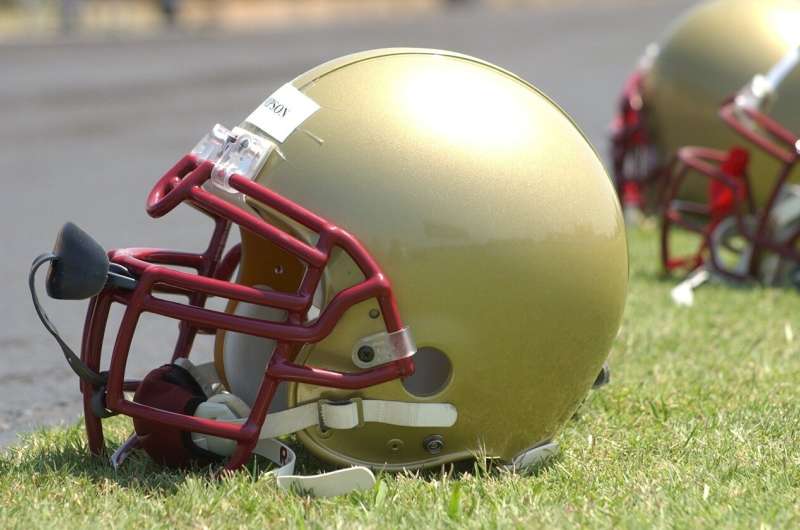This article has been reviewed according to Science X's editorial process and policies. Editors have highlighted the following attributes while ensuring the content's credibility:
fact-checked
trusted source
proofread
New high-tech helmets may protect American football players from debilitating concussions

Millions of people in the US are concussed every year playing sports. Players of games like American football are at particularly high risk for injuries that can have devastating long-term consequences. Stanford University scientists working with the company Savior Brain have now designed one potential way of protecting players: a helmet containing liquid shock absorbers that could reduce the impact of blows to the head by a third.
"Most of the members of our team have a personal connection to traumatic brain injury and we care deeply about ensuring long-term athlete brain health," said Nicholas Cecchi, a Ph.D. candidate at Stanford University and lead author of the study in Frontiers in Bioengineering and Biotechnology. "Concussion and repeated head impacts are still a major problem in contact sports, and we believe that improved helmet technology can play an important role in reducing the risk of brain injury."
HARM reduction
Previous research by the Camarillo Lab at Stanford University had suggested that liquid shock absorbers could provide improved protection in sports helmets. To investigate this, the team built a finite element model, used by engineers to simulate performance before manufacturing, of an American football helmet incorporating 21 liquid shock absorbers. This helmet was tested against simulations of the helmet performance evaluation protocol used by the National Football League (NFL), its performance compared to that of four existing helmets.
Due to the mounting evidence that the cumulative effect of impacts which don't cause diagnosed concussions can also have serious health consequences, the team added lower velocity impacts to the evaluation protocol. They measured the head kinematics for each impact to produce a Head Accelerate Response Metric (HARM) score, which is used to evaluate helmet performance under impact. The kinematics were also fed into a model of the head and brain to gauge the resulting strain on the brain.
Reducing impact by 33%
The results showed that the helmet with liquid shock absorbers could dramatically reduce impact severity and strain on the brain caused by head impacts, potentially significantly cutting injuries. The helmet with liquid shock absorbers performed better than the existing helmet models, producing the lowest HARM value in 33 out of 36 different impact conditions tested, with an average reduction in score of a third.
The liquid helmet also had the best "Helmet Performance Score," a measure used in the NFL's annual helmet safety rankings, which includes a weighting for how well a helmet protects against blows in different areas of the head. The highest-weighted location is the 'side upper' portion of the helmet because impacts here are most likely to cause concussions: the helmet with liquid shock absorbers reduced the HARM score in this area by 39-50% across all impact velocities without compromising protection in other areas of the helmet.
"The liquid technology offered an average improvement of over 30% for both low and high velocities," said Dr. Yuzhe Liu, corresponding author, who completed the work as a postdoctoral scholar at Stanford University. "It can dramatically reduce the loading on the brain that is experienced during all kinds of American football impacts."
The team intends to develop the model significantly to protect players better—for instance by incorporating improvements to the facemask and chinstrap. They also plan to develop the model into a physical helmet that could be tested in real-life conditions, and in the future to produce similar helmets for other sports. However, different levels of play or different sports may need assessment by different metrics and design redevelopment.
"The next step for our team is to translate the computer model to a physical prototype," said Cecchi. "After successfully completing that, we would also be interested in conducting human studies that could demonstrate either a reduction in concussion incidence or an attenuation of impact severity for sub-concussive impacts. We have plans to expand our implementation of liquid shock absorbers to more areas of the helmet, and more helmeted applications, to further improve brain safety for a wide variety of populations."
More information: Nicholas Cecchi et al, Finite element evaluation of an American football helmet featuring liquid shock absorbers for protecting against concussive and subconcussive head impacts, Frontiers in Bioengineering and Biotechnology (2023). DOI: 10.3389/fbioe.2023.1160387


















